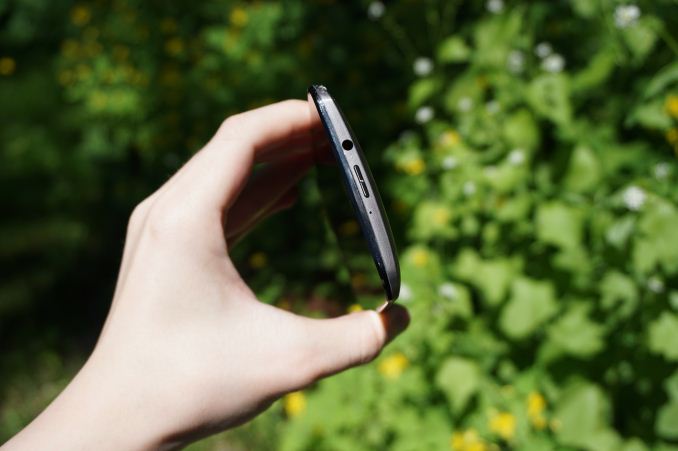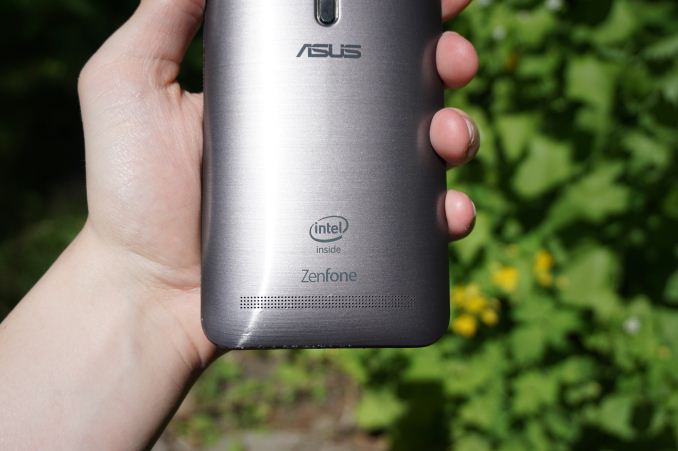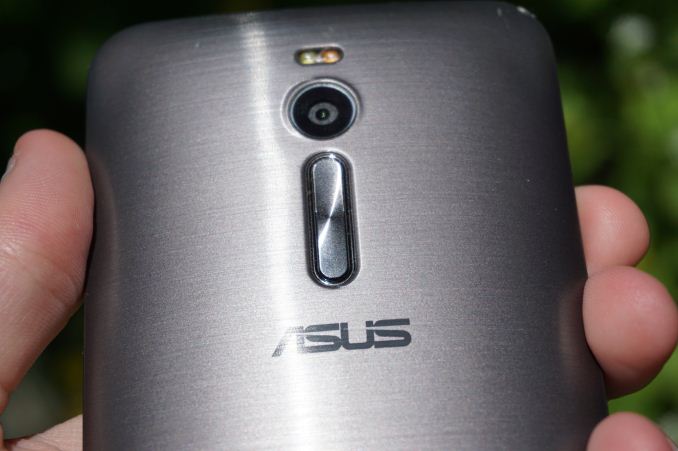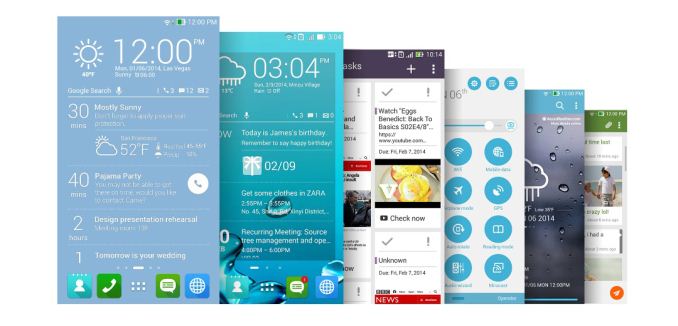The ASUS ZenFone 2 Review
by Brandon Chester on May 26, 2015 8:00 AM ESTFinal Words
Throughout the course of this review you may have noticed that I often compared the ZenFone 2 to high end smartphones like the Galaxy S6, the iPhone 5s and 6, the LG G3, etc. You may have felt that it was unfair to do so, as those smartphones will cost anywhere between two and four times as much as the ZenFone 2 depending on which model of each device you are comparing. In terms of price, the ZenFone 2 is competing with devices like the Moto G and the Lumia 735. You would be right to say that my comparisons have been very unfair. However, I think it says a great deal about the ZenFone 2's quality when the most relevant comparisons are often to devices that cost multiple times as much. It's a compliment toward ASUS and the work they've done to bring a high quality device to such a low price.
When discussing the ZenFone 2, I often find myself reminded of the Nexus 7, and more specifically the second generation model. It makes sense that I would be, as the Nexus 7 was also made by ASUS, and in many ways was similar to the ZenFone 2 in what it hoped to achieve. It had one of the best SoCs you could find in an Android device at the time, a class leading display, and great battery life. It put all of those things into a well built device that was only $219, well below the prices of the competition. The ZenFone 2 feels like ASUS bringing those same goals to the smartphone space. While the ZenFone 2's display isn't quite as good as the second generation Nexus 7 was, it's still very good relative to the price of the phone. That's a statement which can be applied to pretty much every other aspect of the ZenFone 2. In many respects it really does compete with phones that are priced significantly higher than it is.
I think the ZenFone 2 is a very well designed device given the price constraints that ASUS is working within. It has some very nice details like the brushed effect on the back cover, as well as the spun metal look on the volume rocker and on the bottom bezel beneath the display. When you hold the ZenFone 2 it's clearly not an aluminum device, and the finish that ASUS has applied to the plastic back cover doesn't try to trick you into thinking otherwise. But at a visual level it has a very convincing aluminum appearance to it, and I'm surprised that ASUS was able to replicate the reflections that brushed aluminum creates with a plastic back cover. The top mounted power button can definitely be a bit frustrating to use, but it's not the end of the world. The inclusion of double tap to wake on the display also reduces the need to use the power button.
ASUS, with the help of Intel, is really pushing the limits of what a smartphone can be when it has to meet such a low price. The ZenFone 2 offers CPU performance that should probably be creating some concern at Qualcomm, Apple, and Samsung. It's very competitive with the silicon that we see in the most expensive flagship phones available, and both ASUS and Intel should be proud. The SoC's GPU performance competitive with the last generation of flagship devices. While that sounds like criticism, the ZenFone 2's GPU performance is actually well ahead of the other devices that compete with it on price. Intel also handles the throttling of their SoC very gracefully, with GPU performance dropping to a point where it can be maintained for long periods of time rather than repeatedly rising and dropping due to the governor always targeting maximum performance.
While the ZenFone 2 has many positive aspects, it's not flawless by any means. The camera performance is very disappointing. I had really hoped that I would have overwhelming praise for the ZenFone 2's camera, as it's a feature that is so often poorly executed, particularly on inexpensive smartphones. Unfortunately, ASUS still has some things to learn when it comes to camera processing, and whatever processing is being done at the ISP level for videos is really not sufficient. I'm hopeful that the issues with JPEG processing can be addressed in future software updates. The camera is clearly capable of taking some good photos, and if ASUS can find somewhere in the middle of their current camera settings and the Optimization off setting then they'll have addressed one of the few major flaws with their device.
The other big flaw is that battery life is certainly not as good as you would expect from a device with a battery of this size. It's surprising to see such a huge gap in battery life between the ZenFone 2 and the OnePlus One which has the same display size and resolution, and nearly the same battery capacity. The lack of PSR and the relatively inefficient display are the biggest cause of the battery drain on the ZenFone 2, and it was very disappointing to discover this during the course of my use and testing. The ZenFone 2 is agonizingly close to being perfect for its price, but the battery life and the camera performance really let it down.
The last major point of the phone to discuss would be the software. Both the current software and software updates are definitely things that needs to be considered when buying the ZenFone 2. Since ASUS is a relatively new Android phone vendor, it's hard to say whether or not users can expect timely Android updates, or whether they can expect updates at all. I won't pass any judgement in that regard, and owners of ASUS tablets could give some insight into the level of support ASUS provides for their Android devices after launch. More relevant to the experience that users will have right now right now is ZenUI, ASUS's skin for Android.
I've heard some scathing criticism of ASUS's ZenUI, but I actually felt like it brought some useful additions to Android and didn't impede performance. I think some of the genuine improvements that OEM interfaces and modifications bring to Android are often overlooked, like having a battery percentage in the status bar, or re-enabling silent mode in the early releases of Lollipop. ZenUI was also one of the smoothest interfaces I've ever used. It's hard to put it into words, but some of the launcher animations felt much less mechanical than they do on stock Android, and I rarely noticed any slowdown or jank.
While I think ZenUI definitely gets a lot of things right, I don't hold the overall software experience on the ZenFone 2 in such a high regard. Much of this has to do with preinstalled bloatware. ASUS is best known as a PC vendor, and the ZenFone has enough useless preinstalled software to rival the amount you get on a Windows computer. It ranges from useless apps like the Mirror app which just turns on the front facing camera, to what is quite frankly shovelware like "50+ Games!" and "Clean Master". I feel somewhat bad though, because the deals to include these apps might be one of the only ways that the phone makes ASUS any money.
I suppose that the final question boils down to whether or not the ZenFone 2 is worth buying. Despite its flaws, I would say that the answer is yes for both models. However, I think it's important to make the right decision about which model you purchase, as the higher end SKU costs 50% more than the entry level one. I don't think the faster max CPU clock on the high end model is really worth considering, and while the 4GB of RAM is something that you can brag about, Android functions perfectly well with 2GB or 3GB of RAM.
I think the most important considerations are actually the BoostMaster charger, and the amount of internal NAND. If you like using a high brightness, or if you frequently use your phone in high display APL scenarios such as web browsing, you're going get less than stellar battery life. Having the ability to charge the phone quickly helps to offset the battery frustration. Buying a fast charger like the Motorola Turbo Charger separately is going to set you back around $35, and at that point it may be worth it to just invest in the $299 model. If you need more than 16GB of storage then the $299 model is definitely the one to buy. If you're okay with slower charging or have a faster charger already, and 16GB is enough for you, then I think the $199 model is a great purchase.
To wrap things up, I'll say that I think the ZenFone 2 is now the device to beat at both of its price points. I think most users who are interested in a phone like the ZenFone 2 will opt for the $199 model, but the $299 model also presents a great value for users who want the higher end specs and the incredibly fast charging. I don't really know where the competition in this part of the market will go, as it's hard to imagine that ASUS or any other vendor could possibly provide even better specs or more features at this price point. ASUS definitely has a great product on their hands, and now that it's available worldwide, users will soon be able to experience it for themselves.















147 Comments
View All Comments
loimlo - Saturday, May 30, 2015 - link
My mom has been using 1st gen, Zenfone 5 for 10 months. ASUS SW update literally broke app compatibility several times during this period. At some time, my mom couldn't disconnect a phone call due to a nasty SW bug! I'd to lock the screen and unlock it again to disconnect. It's not the end of world, but still an alarming for potential 2nd gen, Zenfone 2 buyers. Fantastic HW value, but subpar SW update quality.ketacdx - Thursday, May 28, 2015 - link
I've been using the TW model since long before the NA launch and there have been a lot of software Updates and ZenUI updates but its not like a beta testing thing. They are fixing issues most manufacturers don't bother with. Little things that they are truly optimizing that a normal person would never notice. Aside from my worry about the quality of the gorilla glass when dropped (think nexus 4 outcomes), the QC elsewhere on this things feels prime. I have no concerns.Dawgmatix - Wednesday, May 27, 2015 - link
Are there any phones with arm processors that use the same display? What does their battery life look like? How can we be sure its not the cpu or gpu that is eating up the battery?Brandon Chester - Wednesday, May 27, 2015 - link
Because the SoC power usage is small relative to display power usage on any device during the browser test, and the ZenFone 2 performs worst of all in that test. In tests where the SoC has a greater impact and the display has a lesser one it actually achieves a battery life closer to that of other devices.YOUCANNOTDENY - Wednesday, May 27, 2015 - link
Hello,I had a few observations/questions. I currently own the $199 version of the Zenfone 2, and have not noticed any dynamic contrast or CABC during my time with the device. This may be because I cannot recognize it, but I'm pretty sure something similar is used in my Dell XPS 13 Ultrabook with Intel's HD Graphics drivers (I promptly disabled the dynamic contrast shifts in Graphics Settings). I have, however, turned off "Smart Saving" in Power Management on the Zenfone 2, so that may be what is causing the difference. I am also on the latest 2.17.40.12 software version, which may have introduced changes.
One other thing, I noticed that in the "Splendid" app, owners can change the color temperature of the screen. I immediately noticed the overly cold white point of the screen when I first powered on the device, so I looked to the Splendid app to change the color temperature. I am currently on "Reading Mode" with default settings on the slider, which makes the screen more bearable to my eyes, but I am still unsure of the absolute color accuracy. If at all convenient, would it be possible to rerun screen accuracy measurements in the various color temperature modes offered in the included "Splendid" application? Perhaps, we may be able to find a setting that makes the most of the included panel and does it justice.
Thank you!
Brandon Chester - Wednesday, May 27, 2015 - link
The CABC is there on both models. I made sure that ASUS's power saving features were disabled before I did my testing.While I could try and adjust vaguely labelled sliders in the Splendid app to fix the display's white point, the gamma and greyscale are not possible to fix because of the CABC. Because of this, there's no point in trying to fix the display.
Quad5Ny - Wednesday, May 27, 2015 - link
@Brandon Chester ASUS stock theme looks like a copy of Solstice by John Bussell (@myeverydayghost) who based his theme on Apple's iOS 7. -- http://modmyi.com/info/solstice.php, http://cydia.saurik.com/package/com.modmyi.solstic...UtilityMax - Wednesday, May 27, 2015 - link
The device is not without flaws, but the $200 model seems like a good value. However, the $200 model is a bit dubious proposition considering how close it is to the OnePlus One.Sammaul - Thursday, May 28, 2015 - link
Have the $300 model, and have used a OnePlus...frankly in real world usage it's kind of a wash. OnePlus has better battery life, camera, and speakers. The Zenfone is absolutely quicker and smoother, even with none of the bloat uninstalled. That 2 channel ram in it does wonders compared to other phones I have used.MoJo JoJo - Wednesday, May 27, 2015 - link
I have been using ZenFone 5 for almost 7-8 months. There's only one thing that I don't like about ASUS is that software and software updates.Software:
ASUS ZenUI is buggy as hell. They provide some update to improve one area and ruins the other. They just cannot provide a single, practically stable, update/ROM. It irritates me a lot. Even now most of the ZenFone 2 users are facing so many issues of Shitty Battery" "Force Stop" "Worse Camera" "Heating under normal use (45 deg.C)
Software Update:
Like I said I have been using ZenFone 5 for 7 months, it seems like ASUS is very slow in updating their devices. First, ASUS launched the 1st gen. ZenFone series in July 2014 (in my country) with Jelly Bean 4.3 instead of KitKat 4.4
After almost 2 months of waiting (Aug-September) they released the KitKat update. That update messed up everything, literally everything. It took another 1-2 updates for ASUS to remove the bugs.
In November 2014 they announced that whole ZenFone series will get the Lollipop update in April 2014. It's almost the starting of June but no ZenFone (intel Version) has got lollipop yet! They are just delaying the update to sort out the bugs. But no use. In May Google has rejected their update during verification. So, still waiting for update, which will be 5.0 not even 5.0.2 (Though they have promissed to give 5.1 update, but it will take ages to come).
Moral of the Story:
No doubt, ASUS is great in providing high end specifications. But it ends there itself. The whole experience gets ruined by the software.